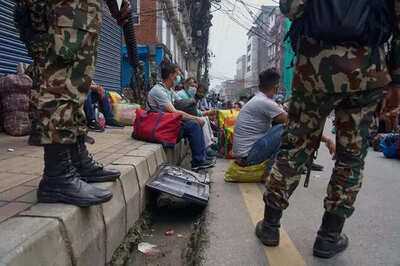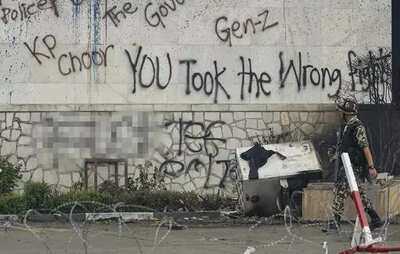A social media campaign by young Nepalis against the lifestyles of " Nepo Kids ", the children of politicians flaunting wealth online, went on to grow into the deadliest unrest Nepal has faced in years and led to the resignation of the prime minister.
On Wednesday morning, soldiers enforced a curfew in Kathmandu as smoke rose from the streets and speculation spread about a possible meeting between leaders of the Gen Z movement , the army, and the president.
This followed two nights of violent protests in which tens of thousands marched, set fire to parliament and the Supreme Court, and clashed with security forces.
The protests began in early September with a peaceful demonstration by young Nepalis frustrated with posts of politicians’ children showing luxury travel and expensive items while most people faced economic difficulties. Discontent had also been building for years over youth unemployment and limited opportunities.
The government’s decision last week to ban more than two dozen social media platforms, including Instagram, Facebook, and WhatsApp, intensified the anger.
What happens next
For now, the army has taken charge. Army chief General Ashok Raj Sigdel met on Wednesday with "representatives of Gen Z," according to a spokesman, though no further details were given. Meanwhile, the Nepal Army extended prohibitory orders in three districts of the Kathmandu Valley on Thursday, while allowing public movement during specific windows. Additionally, two persons died and more than a dozen inmates were injured when army troops opened fire on Thursday morning to stop a mass breakout from Ramechhap District Prison, local media reports said.

Moreover, analysts said creating a "transitional arrangement" with broad legitimacy may be difficult, especially since the protesters have no single leader.
Constitutional process
Nepal’s 2015 constitution requires that a new prime minister be appointed from the party with a majority in parliament. If no party has a majority, the president appoints someone who can demonstrate support and they must secure a confidence vote within 30 days. If they fail, other members may try, and if none succeed, the house can be dissolved and elections held.
Protesters, however, have expressed distrust of major party leaders, many of whom are in hiding. It is unclear whether they will accept this constitutional process.
Possibility of interim government
The constitution does not mention an interim government, but some experts suggest one could be created outside of the formal process if agreed upon.
"Such a government can pursue the agenda for change that Gen Z want and also hold elections for a new parliament within six months," constitutional expert Bipin Adhikari was quoted as saying by the news agency Reuters, adding it should include broad representation.

Former chief justice seen as top choice
Sushila Karki, Nepal’s former chief justice, has emerged as the leading candidate to head an interim government, according to a representative of the protesters.
"Right now, Sushila Karki’s name is coming up to lead the interim government — we are now waiting for the president to make a move," Rakshya Bam, who attended a meeting with the army chief about the country’s leadership, was quoted as saying by the news agency AFP.
Who might protesters support?
Protesters are also likely to support Balendra Shah, 35, a rapper and music composer who was elected mayor of Kathmandu in 2022 and has gained popularity among young people for his work to clean the city.
Another possible choice is Rabi Lamichhane, a former television journalist who entered politics in 2022 by forming the Rastriya Swatantra Party.
According to local media reports, protesters freed Lamichhane from prison on Tuesday, where he had been held while facing trial over alleged misuse of funds.
On Wednesday morning, soldiers enforced a curfew in Kathmandu as smoke rose from the streets and speculation spread about a possible meeting between leaders of the Gen Z movement , the army, and the president.
This followed two nights of violent protests in which tens of thousands marched, set fire to parliament and the Supreme Court, and clashed with security forces.
The protests began in early September with a peaceful demonstration by young Nepalis frustrated with posts of politicians’ children showing luxury travel and expensive items while most people faced economic difficulties. Discontent had also been building for years over youth unemployment and limited opportunities.
The government’s decision last week to ban more than two dozen social media platforms, including Instagram, Facebook, and WhatsApp, intensified the anger.
What happens next
For now, the army has taken charge. Army chief General Ashok Raj Sigdel met on Wednesday with "representatives of Gen Z," according to a spokesman, though no further details were given. Meanwhile, the Nepal Army extended prohibitory orders in three districts of the Kathmandu Valley on Thursday, while allowing public movement during specific windows. Additionally, two persons died and more than a dozen inmates were injured when army troops opened fire on Thursday morning to stop a mass breakout from Ramechhap District Prison, local media reports said.
Moreover, analysts said creating a "transitional arrangement" with broad legitimacy may be difficult, especially since the protesters have no single leader.
Constitutional process
Nepal’s 2015 constitution requires that a new prime minister be appointed from the party with a majority in parliament. If no party has a majority, the president appoints someone who can demonstrate support and they must secure a confidence vote within 30 days. If they fail, other members may try, and if none succeed, the house can be dissolved and elections held.
Protesters, however, have expressed distrust of major party leaders, many of whom are in hiding. It is unclear whether they will accept this constitutional process.
Possibility of interim government
The constitution does not mention an interim government, but some experts suggest one could be created outside of the formal process if agreed upon.
"Such a government can pursue the agenda for change that Gen Z want and also hold elections for a new parliament within six months," constitutional expert Bipin Adhikari was quoted as saying by the news agency Reuters, adding it should include broad representation.
Former chief justice seen as top choice
Sushila Karki, Nepal’s former chief justice, has emerged as the leading candidate to head an interim government, according to a representative of the protesters.
"Right now, Sushila Karki’s name is coming up to lead the interim government — we are now waiting for the president to make a move," Rakshya Bam, who attended a meeting with the army chief about the country’s leadership, was quoted as saying by the news agency AFP.
Who might protesters support?
Protesters are also likely to support Balendra Shah, 35, a rapper and music composer who was elected mayor of Kathmandu in 2022 and has gained popularity among young people for his work to clean the city.
Another possible choice is Rabi Lamichhane, a former television journalist who entered politics in 2022 by forming the Rastriya Swatantra Party.
According to local media reports, protesters freed Lamichhane from prison on Tuesday, where he had been held while facing trial over alleged misuse of funds.
You may also like

RBI may go for 1 more rates cut; GST reform and festive spending to boost growth

PM Modi to visit Maharashtra from Oct 8-9; to meet UK PM in Mumbai and inaugurate several connectivity projects

CAT 2025 Application Correction Window Closes Today At iimcat.ac.in; Check Editable And Non-Editable Fields

Sacramento helicopter crash horror as air ambulance plunges upside down onto busy highway

Inspired Generations Of Players: Harbhajan's Warm Birthday Wishes For Zaheer






